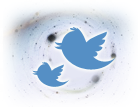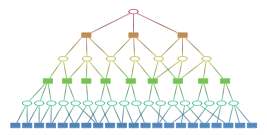Community Embraces New Word Game at Mid-Year Play Day This past Sunday, families at Takoma Park’s Seventh Annual Mid-Year Play Day had the opportunity to experience OtherWordly for the first time. Our educational language game drew curious children and parents to our table throughout the afternoon. Words in Space Several children gathered around our iPads […]
Read more On Twitter, almost no one hears you. Or at least that’s the case for 99.95% of Twitter users whose Tweets evaporate into the aether, scrolling off the feed, leaving scarcely a trace.
On Twitter, almost no one hears you. Or at least that’s the case for 99.95% of Twitter users whose Tweets evaporate into the aether, scrolling off the feed, leaving scarcely a trace.
According to statistics released last week by Twitter, users now send a billion Tweets a week (up nearly 3x from 350M a year ago). But most of those Tweets get little attention, reports a new study, to be presented next week at a web conference in India. The study found that attention is highly concentrated among a very narrow slice of Twitter users. Read on for more about the findings…
- Audience attention is fragmented — Even more than other mass media (television, newspapers, blogs) followers’ attention is fragmented across a wide pool of content producers. The researchers say “roughly 0.05% of the population accounts for almost half of all attention. Within the population of elite users, moreover, attention is highly homophilous, with celebrities following celebrities, media following media, and bloggers following bloggers.”
- Curation is valuable — Among information that originates in the media, almost half passes indirectly to the masses via a diffuse intermediary layer of opinion leaders who are more exposed to the media than their followers. This is a vital curation role. It’s the reason you might follow IDEA on Twitter, or anyone else that delivers interesting links. The role of selecting interesting articles and adding commentary is a vital part of the information ecosystem. (For more about the value of curation and commentary, see TechDirt’s posts on short vs long form writing and the value of aggregators.)
- Organizations don’t talk business — The researchers found that organizations “devote a surprisingly small fraction of their attention to business-related news.” This could be a void.
- Multimedia lives longer than news — The researchers say, “We also find that different types of content exhibit very different lifespans. In particular, media-originated URLs are disproporionately represented among short-lived URLs while those originated by bloggers tend to be overrepresented among long-lived URLs. Finally, we find that the longest-lived URLs are dominated by content such as videos and music, which are continually being rediscovered by Twitter users and appear to persist indefinitely.”
What this means
 Since being read on Twitter relies on both direct outreach and the trickle-down effect of being retweeted, the amount of impact you have increases exponentially with how many followers you have (the snowball effect is illustrated at right). Twice the followers is more than twice the impact. If you reach a critical mass, you can avoid the black hole.
Since being read on Twitter relies on both direct outreach and the trickle-down effect of being retweeted, the amount of impact you have increases exponentially with how many followers you have (the snowball effect is illustrated at right). Twice the followers is more than twice the impact. If you reach a critical mass, you can avoid the black hole.
It is realistic for Tweeters doing science and culture outreach to get into the top 0.05% of Twitter users. Let’s look at what it takes.
In April 2010, Twitter reported 105M registered users, and 300k new user signups per day. Last week, that was up to 460k new accounts per day. At that rate, Twitter now has approx 240M registered users. But “registered users” grossly overestimates the Twitterverse. The actual number of bonafide Twitter users is considerably smaller. A study by RJMetrics in Jan 2010 found that a large number of Twitter accounts are inactive, with about 25% having no followers and 40% not having sent a single tweet. About 80% of all Twitter users have tweeted fewer than ten times. That corresponds to approximately 48 million real Twitter users. So you may want to be in the top 1/4% of the real users. That is, in the top 120k of all Twitter users. (Note the paper says top 20k users, but that was based on early 2010 numbers.)
There are many ways to measure “ranking” in Twitter, but the simplest is to count followers. According to the Twitter stats site TwitterCounter, the top 120k Tweeters currently corresponds to approximately 2000 followers. To be in the top 50k you need around 6500 followers.
Of course, two thousand followers is no guarantee of anything, but this is a useful target number to know when your work on Twitter has reached a point that your Tweets are in the rarefied air of high-impact Tweeting.
But the quality of connections is paramount. According to Joerg Heber, senior editor of the science magazine Nature Materials, who Tweets as @joergheber (currently he has 2894 followers), “If you have high-profile followers, it will be easier to have broader impact.” He says that his account “seemed to really take off once I had about 100 to 200 followers. The main concern is to whom you are connected.”
Information about the study
The study, “Who Says What to Whom on Twitter” by Shaomei Wu at Cornell, and three colleagues at Yahoo! Research, will be presented next week at the International World Wide Web Conference, in Hyderabad, India.
The researchers investigated several longstanding questions in media communications research, in the context of the microblogging service Twitter, regarding the production, flow, and consumption of information. For data, they used a database of 42M users from summer 2009, an extract of 260M messages containing bit.ly URLs transmitted from the Twitter firehose between summer 2009 and Spring 2010, and a dump of 750k users and 5M lists during the same time period.
They differentiated between elite users, which they defined as: celebrities, bloggers, and representatives of media outlets and other formal organizations, and ordinary users.
Update: Added comment from Joerg Heber, a science Tweeter.


17 Mar 2011, 2:03 pm
[…] IDEA » Black hole of Tweets: New research on which Tweeters get attention. […]
18 Mar 2011, 6:32 am
[…] Tweets Black Hole (analysis of the tweets that get ignored) – http://www.idea.org/blog/2011/03/17/black-hole-of-tweets-new-research-on-which-tweeters-get-attentio… […]
19 Mar 2011, 5:51 pm
[…] {"data_track_clickback":true,"ui_language":"en"}; Twitter is continuing to grow in popularity with about 460K new users joining each day compared to about 300K last […]
31 Mar 2011, 11:16 am
[…] A target audience can be defined by specific occupations (as in the diagram below), or can be stratified by age, educational levels, demographics, interests, roles/relationships, etc. Many people fall into multiple audience categories. The craft of social media lies in selecting and creating content for your audience. (See our post about the value of curating information on Twitter) […]